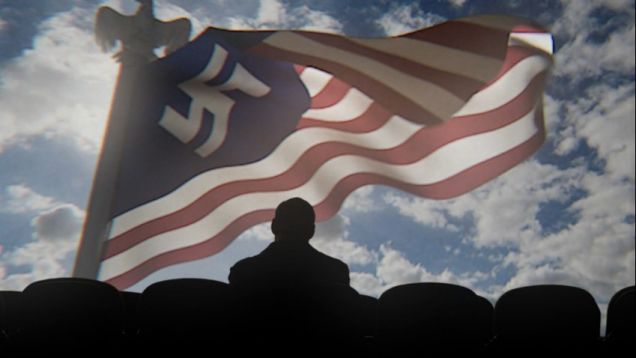amazon’s The Man in the High Castle (2015)
Insta-score: 4 out of 5.
Short form: After a slow start, this builds to an excellent show.
Spoilers below the fold.
Amazon decided to adapt Philip K. Dick’s The Man in the High Castle into a 10-episode TV series. This was always going to be quite the challenge, given how trippy and non-linear and so-very-1960s the original book is. Given the realities of TV, the Amazon series is about the best one can hope for as an adaptation, and stands pretty well on its own right.
Micro-summary of the setting and plot: In an alternate history, the Axis Powers emerge victorious in World War II (due to the success of the 1933 assassination attempt on FDR), conquering the United States in 1947 and dividing North America into three zone: The Greater Nazi Reich; the Japanese-dominated Pacific States of America; and an ill-defined Neutral Zone comprising the Rocky Mountains, lying between the two empires. The series follows a number of characters, but focuses mainly on Juliana Crain and Joe Blake.
Juliana’s arc begins when her half-sister passes to her a piece of contraband (a banned newsreel called The Grasshopper Lies Heavy) and is subsequently shot by the Japanese occupation police (the Kempetai). Juliana resolves to complete her sister’s mission to deliver the reel to the mysterious Man in the High Castle, which takes her into the Neutral Zone and away from her boyfriend Frank Frink. On the other side of the continent, Joe Blake worms his way into the Resistance, which tasks him with delivering a different copy of the newsreel.
There are loads and loads of characters and an intricate weaving of different plots. It’s well worth the watch just to see how things play out.
The atmosphere of this work is impressive. It feels very authentic (and since one thread is the question of what does “authentic” mean, anyway?, that’s appropriate). It feels like 1962 but it also feels like an occupied land. The cinematography is lush and vibrant, and really makes the alternate reality feel real. German-occupied New York is ritzy and shiny (most parts, any way), with a fantastic alternate Times Square setting the stage. The Nazis are polished and correct, with rocket planes roaring overhead and a TV in every house. There’s also a glimpse into suburbia on the replacement holiday for Independence Day (fittingly enough, “Victory over America Day”), and it is positively chilling how easily the Nazi motifs slip into the 1960s American Dream. The Japanese city of San Francisco, on the other hand, is formal and polite. Most of the city seems the same but the additions stand out — especially the Nazi embassy, which seems plucked out of Speer’s fever dreams and contrasts sharply with the charm of San Francisco.
In between, there is the Neutral Zone: washed out, gray, depressed. It looks a lot like popular conceptions of Eastern Europe in the 1980s, which is fitting since it is basically a Cold War buffer state. Like the people, the buildings are beaten down, weary and defeated. Although the Canon City (Neutral Zone) scenes don’t work as well as the others, there is one moment that brings sharp pain: The camera pans across a rundown street and we see, plastered all over one wall, many decayed and fading WW II propaganda posters exhorting the townsfolk to a victory we know they never found.
Though sprinkled with drama and danger, this is not, by and by, an action-packed series. Indeed, the beginning is sloooow, taking its time showing us the world and introducing the characters. Its pace is languid, nearly fatally so. But once the characters leave the Neutral Zone and the show can return to New York and San Francisco (and, to be frank, once the focus shifts away from the bland Juliana and Joe), the pace picks up and it emerges from its narrative cocoon. The shift in focus toward political machinations and the building war tension boosts the series to the realm of gripping, must-watch TV. (An entirely personal barometer: It took me two weeks after the pilot to watch episode 2; I binged the entire second half of the season in a day.)
By the end, things have advanced but not much has been made clear (so, they channeled Phillip K. Dick well). The significance of the newsreels hasn’t been explained, but the (possible) identity of the Man in the High Castle has — and if the hint is true, the implications are fascinating. Also, the very last scene reminds us that anyone living in a PKD world lives on the knife-edge of real and unreal, and maybe the viewers do too.
All in all, it was time well spent and a good example of the new Golden Age in TV. I look forward to Season 2.

Leave a Reply
You must be logged in to post a comment.